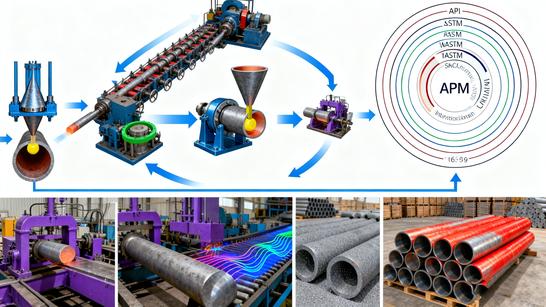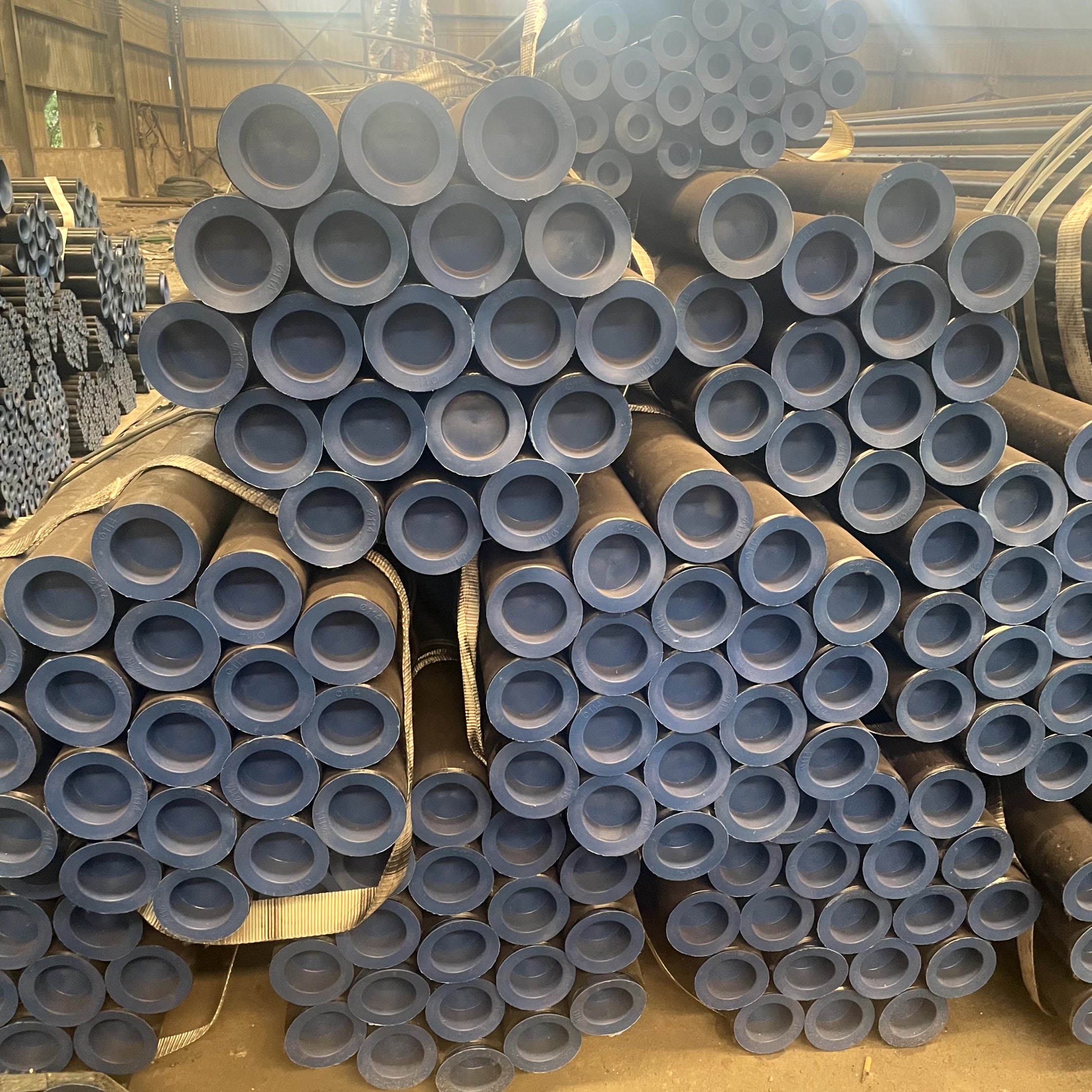In energy-intensive industries like oil & gas exploration, power generation, and heavy chemical engineering, seamless pipes that can withstand extreme pressures, harsh media, and heavy loads are the backbone of infrastructure. Products such as hot-finished seamless pipes (also known as hot rolled seamless pipes), heavy-wall seamless steel pipes, high-pressure seamless pipes, oil and gas pipeline steel pipes, and power plant seamless steel tubes play irreplaceable roles in ensuring stable operation of key projects. This guide systematically breaks down their definitions, core properties, industry standards, selection strategies, and practical applications, providing actionable insights for engineers, project managers, and procurement teams.
1. Core Definitions: Clarifying Key Seamless Pipe Variants
Each type of seamless pipe is engineered to address specific industrial challenges, with distinct manufacturing processes and performance focuses. Understanding their fundamental definitions is critical for correct application.
1.1 Hot-Finished (Hot Rolled) Seamless Pipe
Hot-finished seamless pipes—often referred to as hot rolled seamless pipes—are produced by heating steel billets to high temperatures (1200–1300℃) and then piercing, rolling, and sizing them. This process delivers unique advantages:
- Excellent material ductility, making it easy to form into large-diameter pipes (outer diameter up to 630mm or more).
- Cost-effectiveness for mass production, as hot rolling requires less energy than cold working.
- Suitable for low-to-medium precision applications, with typical dimensional tolerance of ±1% for outer diameter and ±10% for wall thickness.
1.2 Heavy-Wall Seamless Steel Pipe
Heavy-wall seamless steel pipes are defined by their thick wall thickness, usually accounting for 10–25% of the outer diameter (e.g., a 219mm outer diameter pipe with a 25mm+ wall thickness). Key characteristics include:
- Exceptional pressure-bearing capacity and structural rigidity, ideal for high-pressure vessels and load-bearing components.
- Enhanced resistance to external impact and deformation, critical for harsh working environments like offshore oil platforms.
- Common wall thickness ranges from 12mm to 100mm, with custom thicker walls available for special projects.
1.3 High-Pressure Seamless Pipe
High-pressure seamless pipes are designed to handle ultra-high working pressures (typically >40MPa, with some grades exceeding 100MPa). They undergo specialized processing to meet strict requirements:
- Strict material selection, often using low-alloy steels (e.g., 20G, 15CrMoG) or alloy steels (e.g., 4130) with high tensile strength (≥600MPa).
- Post-manufacturing heat treatment (e.g., quenching and tempering) to improve creep resistance and fatigue strength.
- Mandatory pressure testing (hydrostatic or pneumatic) at 1.5 times the design pressure to ensure leak tightness.
1.4 Oil and Gas Pipeline Steel Pipe
Oil and gas pipeline steel pipes (also called energy transmission seamless pipes) are tailored for transporting crude oil, natural gas, and refined petroleum products. Their core features include:
- Strong corrosion resistance, with options like 3PE anti-corrosion coating (for soil/water environments) or stainless steel materials (for acidic media).
- High toughness to withstand soil pressure, temperature fluctuations, and seismic activity during long-distance transportation.
- Compliance with strict weldability standards, as most pipeline projects require on-site welding of pipe sections.
1.5 Power Plant Seamless Steel Tube
Power plant seamless steel tubes are specialized for thermal power, nuclear power, and renewable energy (e.g., solar thermal) plants. They must endure extreme temperature and pressure conditions:
- Heat resistance, with grades like 12Cr1MoVG suitable for superheater/reheater systems (operating temperatures 540–570℃).
- Resistance to steam oxidation and hydrogen corrosion, which are common in boiler water/steam cycles.
- Precise dimensional control to ensure compatibility with boiler headers and other components.
2. Key Standards and Performance Benchmarks
International and industry-specific standards ensure the quality, safety, and interchangeability of seamless pipes across global projects. Below are the most influential standards and their core requirements.
2.1 Global General Standards
| Standard | Applicable Products | Core Requirements |
|---|---|---|
| ASTM A53 | Hot-finished seamless pipes | Specifies carbon steel materials (Grades A/B) with minimum tensile strength 330MPa; used for low-pressure water/gas pipelines. |
| API 5L | Oil and gas pipeline steel pipes | Covers carbon steel and low-alloy steel grades (e.g., X42, X52, X65); mandates toughness testing (-20℃ impact test) and corrosion resistance evaluation. |
| EN 10210 | Hot-finished heavy-wall seamless pipes | Defines wall thickness tolerance (±12.5%) and mechanical properties (minimum yield strength 235MPa for S235JR grade); used for structural and pressure applications. |
2.2 Industry-Specific Standards
- Power Generation: ASTM A213 (for boiler superheater/reheater tubes) requires creep testing at 650℃ for 10,000 hours; DIN 17175 (German standard) specifies material composition for steam-carrying tubes (e.g., 15Mo3 alloy steel).
- High-Pressure Applications: ASME B36.10M (for high-pressure seamless pipes) defines wall thickness schedules (e.g., Schedule 80, Schedule 160) to match pressure ratings; GB 9948 (Chinese standard) regulates seamless steel pipes for oil refining (working pressure up to 80MPa).
- Oil & Gas Offshore: ISO 3183 (for offshore oil pipelines) mandates additional testing for underwater performance, including hydrogen-induced cracking (HIC) resistance and seawater corrosion testing.
3. Selection Guide: Matching Pipes to Project Needs
Selecting the right seamless pipe requires a comprehensive assessment of operating conditions, project requirements, and cost-efficiency. Follow these four steps for optimal selection:
3.1 Analyze Operating Conditions
- Pressure: For low-pressure oil pipelines (<10MPa), choose ASTM A53 hot-finished seamless pipes; for high-pressure gas injection systems (>60MPa), select API 5L X65 high-pressure seamless pipes.
- Temperature: Power plant superheaters (540℃) need ASTM A213 12Cr1MoVG tubes; low-temperature natural gas pipelines (-40℃) require API 5L X52 pipes with low-temperature toughness.
- Media: Acidic oilfields demand corrosion-resistant oil and gas pipeline steel pipes (e.g., 316L stainless steel); freshwater pipelines can use cost-effective carbon steel hot-rolled seamless pipes.
3.2 Confirm Material and Wall Thickness
- Material: Carbon steel (e.g., Q235B) for non-corrosive, low-pressure scenarios; low-alloy steel (e.g., 15CrMoG) for high-temperature/pressure power plant applications; stainless steel (e.g., 304L) for corrosive oil/gas environments.
- Wall Thickness: Calculate based on the formula for pressure vessel design (considering safety factor). For example, a 10MPa natural gas pipeline (outer diameter 168mm) requires a minimum wall thickness of 8mm (API 5L X52 grade), so select a heavy-wall seamless steel pipe with 10mm thickness for extra safety.
3.3 Evaluate Manufacturing Processes
- Hot-Finished vs. Cold-Finished: Hot-finished (hot rolled) seamless pipes are better for large-diameter, low-precision projects (e.g., long-distance oil pipelines); cold-finished pipes are for small-diameter, high-precision applications (not covered in this guide).
- Coating Options: For buried oil pipelines, choose 3PE-coated oil and gas pipeline steel pipes (service life up to 30 years); for above-ground power plant tubes, use aluminum-silicon coating to resist high-temperature oxidation.
3.4 Verify Certifications and Quality Testing
Prioritize suppliers with certifications like ISO 9001 (quality management), API Q1 (oil & gas industry), and ASME BPVC (boiler/pressure vessel). Request the following test reports:
- Chemical composition analysis (via optical emission spectrometry).
- Mechanical property testing (tensile, impact, hardness).
- Non-destructive testing (ultrasonic testing for internal defects, magnetic particle testing for surface cracks).
4. Application Cases: Oil & Gas and Power Sectors
4.1 Oil & Gas Industry
- Long-Distance Crude Oil Pipeline: A 1,200km pipeline project uses API 5L X52 hot-finished seamless pipes (outer diameter 508mm, wall thickness 12mm). The pipes are 3PE-coated for corrosion resistance, with a design pressure of 12MPa, enabling safe transportation of 5 million tons of crude oil annually.
- Offshore Gas Wellhead: Offshore platforms use heavy-wall seamless steel pipes (API 5L X65, outer diameter 114mm, wall thickness 20mm) for wellhead manifolds. These pipes withstand 45MPa pressure and pass HIC testing, ensuring resistance to seawater corrosion and hydrogen damage.
- Oil Refinery Furnace Tubes: High-pressure seamless pipes (GB 9948 20G, outer diameter 89mm, wall thickness 14mm) are used in catalytic cracking furnaces. They operate at 480℃ and 35MPa, with quenching-tempering heat treatment to prevent creep deformation.
4.2 Power Generation Industry
- Thermal Power Plant Boiler: Superheater systems use ASTM A213 12Cr1MoVG power plant seamless steel tubes (outer diameter 38mm, wall thickness 7mm). These tubes endure 540℃ steam temperature and 25MPa pressure, with a service life of 15–20 years.
- Nuclear Power Plant Cooling Pipeline: Heavy-wall seamless steel pipes (EN 10210 S355JR, outer diameter 325mm, wall thickness 28mm) are used for primary cooling loops. They meet strict radiation resistance requirements and undergo 100% radiographic testing to ensure no defects.
- Solar Thermal Power Plant: Heat collection pipelines use hot-finished seamless pipes (ASTM A53 Grade B, outer diameter 219mm, wall thickness 10mm) with high-temperature paint coating. They transport heat-transfer oil at 390℃, supporting efficient energy conversion.
5. Quality Control and Maintenance Best Practices
5.1 Manufacturing Process Control
- Hot Rolling: Monitor billet heating temperature (±20℃) to avoid overheating or underheating; control rolling speed (1–3 m/s) to ensure uniform wall thickness.
- Heat Treatment: For high-pressure seamless pipes, use computer-controlled quenching-tempering lines (cooling rate 15–20℃/s) to ensure consistent mechanical properties across the pipe length.
- Coating Application: For 3PE-coated oil and gas pipeline steel pipes, ensure coating thickness (2.5–3.0mm) and adhesion (peel strength ≥100N/cm) to prevent coating peeling during transportation.
5.2 Installation and Post-Operation Maintenance
- Installation: Use automatic welding machines for oil and gas pipeline steel pipes to ensure weld strength (tensile strength ≥90% of base metal); conduct hydrostatic testing at 1.5 times design pressure after installation.
- Routine Inspection: For power plant seamless steel tubes, perform annual ultrasonic testing to check for wall thinning (replace if thinning exceeds 20%); for oil pipelines, use intelligent pigging (internal inspection tools) every 3–5 years to detect corrosion or deformation.
- Corrosion Protection: For buried pipes, maintain cathodic protection systems (potential -0.85V to -1.2V) to prevent soil corrosion; for above-ground power plant tubes, clean scale buildup every 2 years to improve heat transfer efficiency.
6. Future Trends: Innovation in Seamless Pipe Technology
6.1 Material Innovation
- High-Strength Low-Alloy (HSLA) Steels: New API 5L X90/X100 grades for oil and gas pipelines reduce wall thickness by 15–20% while maintaining pressure capacity, lowering transportation and installation costs.
- Corrosion-Resistant Alloys (CRAs): Nickel-based alloy pipes (e.g., Inconel 625) for ultra-deepwater oilfields (depth >3000m) offer 5–10 times better corrosion resistance than carbon steel, extending service life to 40+ years.
6.2 Process Upgrade
- Intelligent Hot Rolling: Adoption of AI-controlled rolling mills (with real-time dimensional monitoring via laser sensors) reduces dimensional tolerance to ±0.5%, improving product consistency.
- Green Manufacturing: Use of electric arc furnaces (EAF) with scrap steel reduces carbon emissions by 30% compared to traditional blast furnaces, aligning with global net-zero goals.
6.3 Smart Monitoring Integration
- Sensor-Embedded Pipes: Oil and gas pipeline steel pipes with built-in pressure/temperature sensors enable real-time remote monitoring, predicting leaks or corrosion 6–12 months in advance.
- Digital Twin Technology: Power plant seamless steel tubes are paired with digital twins to simulate creep and fatigue damage, optimizing maintenance schedules and reducing unplanned downtime by 25%.
Conclusion
Hot-finished (hot rolled) seamless pipes, heavy-wall seamless steel pipes, high-pressure seamless pipes, and their industry-specific variants (oil and gas pipeline steel pipes, power plant seamless steel tubes) are critical to the reliability and efficiency of energy infrastructure. By understanding their definitions, standards, and selection criteria, and implementing strict quality control and maintenance, project teams can minimize risks, reduce costs, and ensure long-term operation. As the energy industry shifts toward cleaner, more efficient solutions, staying updated on material innovations and smart technologies will be key to leveraging seamless pipes for future-focused projects. For customized pipe solutions (e.g., ultra-thick wall pipes, corrosion-resistant alloys), collaborate with manufacturers with R&D capabilities to meet unique project demands.





